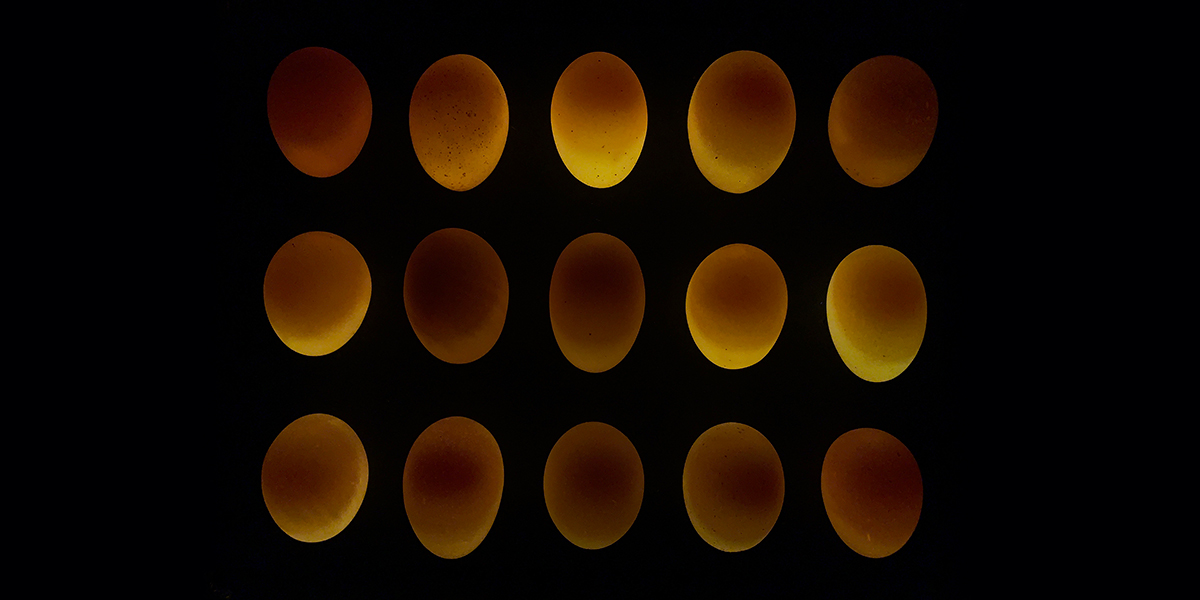Que vous soyez éleveur ou gestionnaire de poulets de chair ou producteur d'œufs de consommation, la qualité de la coquille d'œuf est une priorité pour votre exploitation. Pour les producteurs d'œufs de consommation, la qualité de la coquille est importante pour garantir que les œufs restent intacts tout au long de la chaîne d'approvisionnement. Pour les éleveurs, il s'agit de développer des œufs solides et aptes à l'éclosion afin d'améliorer la viabilité des embryons. Quel que soit le marché, les œufs fêlés ou cassés ont un impact négatif sur vos résultats.
La translucidité est un paramètre qui doit être surveillé en ce qui concerne la qualité de la coquille d'œuf. Les coquilles translucides sont le signe que les œufs ne se sont pas formés correctement et peuvent entraîner des ruptures de coquilles et une réduction de l'éclosabilité. Lorsque vous utilisez les bons outils d'analyse, vous pouvez voir partiellement à travers les coquilles d'œufs qui ont un niveau élevé de translucidité. Cela signifie que la membrane, la matrice de collagène et la coquille elle-même n'ont pas été suffisamment minéralisées pour se former correctement.
La qualité de la coquille d'œuf doit être surveillée en permanence. Étant donné que les œufs sont formés et produits quotidiennement, la qualité de la coquille peut fluctuer tout aussi souvent. Il se peut que la qualité de la coquille soit bonne aujourd'hui, mais qu'il suffise d'une journée chaude pour qu'elle ait un impact négatif le lendemain. Il peut aussi s'agir simplement du stress lié à l'arrivée d'une personne inconnue dans le poulailler un jour donné. L'hygiène et la biosécurité de l'exploitation peuvent également jouer un rôle, car les maladies et les infections peuvent modifier la translucidité de la coquille d'œuf.
Dans cet article, nous allons examiner les facteurs qui peuvent augmenter la translucidité de la coquille et explorer quelques solutions pour améliorer la qualité de la coquille dans votre exploitation.
Réduire le stress pour diminuer la translucidité de la coquille d'œuf
Le stress thermique peut entraîner une augmentation de la translucidité de la coquille de l'œuf. Lorsque les poules halètent, elles perdent du CO2 par la respiration, ce qui rend le pH de leur sang plus alcalin et réduit la quantité de calcium dans le sang, ce qui peut entraîner des problèmes osseux. La formation de la coquille d'œuf nécessitant des niveaux élevés de calcium, une réduction peut entraîner le développement d'œufs à la coquille translucide.
L'apparition d'une maladie dans votre élevage obligera vos poules reproductrices à détourner des nutriments essentiels de la production d'œufs au profit du système immunitaire pour se défendre contre l'infection. Cela signifie que moins de nutriments, comme le zinc, le manganèse et le cuivre, seront disponibles pour produire la membrane, la matrice de collagène et la coquille d'œuf elle-même, ce qui conduira à des œufs translucides.
L'amélioration de la biosécurité dans les élevages pour prévenir les infections, la mise en œuvre de systèmes efficaces de réduction de la chaleur pour réduire le stress thermique et l'investissement dans un bon programme de vaccination sont autant d'éléments clés pour réduire la translucidité de la coquille de l'œuf. En outre, vous pouvez améliorer la nutrition en Zinpro Performance Minerals®.
Les oligo-éléments sont essentiels à la formation de la coquille d'œuf
Les oligo-éléments, notamment le zinc, le manganèse, le cuivre et le sélénium, jouent un rôle dans la formation d'une coquille d'œuf de qualité.
Par exemple, le cuivre est nécessaire à la formation des membranes interne et externe. Le manganèse est essentiel à la formation de la matrice de collagène et le zinc est nécessaire à l'enzyme responsable de la formation du carbonate de calcium, avant qu'il ne se dépose dans la coquille de l'œuf. Le sélénium est également important en raison de son rôle d'antioxydant, contribuant à réduire le stress oxydatif qui peut détourner les nutriments de la production de la coquille d'œuf.
Les oligo-éléments des Zinpro Performance Minerals® utilisent un mode de transport unique vers la paroi intestinale, ce qui permet une meilleure absorption. Ainsi, si les oiseaux sont confrontés à un stress thermique ou à une infection, vous pouvez être sûr qu'ils seront en mesure d'apporter une réponse solide et qu'il leur restera suffisamment de minéraux pour continuer à alimenter la production d'œufs.
Et Zinpro, c'est bien plus que des minéraux. Nous disposons d'un ensemble complet de produits, de services et d'expertise pour vous aider à mesurer la translucidité de la coquille d'œuf et à apporter des améliorations à votre programme nutritionnel, à vos installations et plus encore, afin d'optimiser les performances de vos poules pondeuses et de vos reproducteurs.
Consultez le site section éleveurs sur notre site web pour découvrir comment nos solutions de performance peuvent améliorer la qualité de la coquille d'œuf. Ensuite, connectons nous pour discuter de la manière dont nous pouvons améliorer les résultats de votre entreprise.

